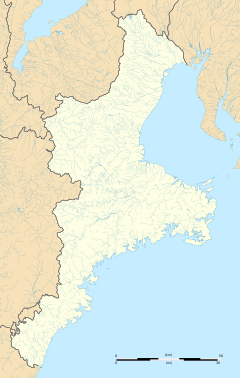Tsu Station (津駅, Tsu-eki) is a junction passenger railway station located in the city of Tsu, Mie Prefecture, operated by Central Japan Railway Company (JR Central), the private railway operator Kintetsu and the third sector Ise Railway. The name of the station is considered the shortest in Japan because it is the only station name that is written with one kana, even though other stations have shorter names when written in Latin letters, such as Oe Station.
Tsu Station 津駅 | |||||
|---|---|---|---|---|---|
 Tsu Station east exit | |||||
| General information | |||||
| Location | 1191-1 Hadokoro-cho, Tsu-shi, Mie-ken 514-0009 Japan | ||||
| Coordinates | 34°44′2.35″N 136°30′36.84″E / 34.7339861°N 136.5102333°E | ||||
| Operated by | |||||
| Line(s) | |||||
| Distance | 15.5 km from Kameyama 22.3 km from Yokkaichi 12.3 km from Ise-Nakagawa | ||||
| Platforms | 2 island + 1 side + 1 bay platform | ||||
| Other information | |||||
| Status | Staffed | ||||
| Station code | E39 | ||||
| Website | Official website | ||||
| History | |||||
| Opened | December 20, 1930 | ||||
| Passengers | |||||
| FY2019 | 3,609 (JR) 15,689 (Kintetsu) 1,691(Ise Railway) daily | ||||
| |||||

Lines
editTsu Station is served by the JR Kisei Main Line, and is located 15.5 km (9.6 mi) from the starting point of the line at Kameyama Station. It is 12.3 km (7.6 mi) from the terminus of the Nagoya Line at Ise-Nakagawa Station. It is also the terminus of the Ise Line and is 22.3 km (13.9 mi) from the opposing terminus at Yokkaichi Station.
Station layout
editThe station consists of four ground-level platforms serving six tracks, connected by pedestrian footbridges. The JR uses one island platform and one side platform and the Kintetsu portion has one island platform. The Ise Railway uses a single bay platform.
Platforms
edit| 1 | ■ Ise Railway Ise Line | Local trains for Yokkaichi, via Suzuka |
| 2 | ■ JR Central Kisei Line | Local trains, Rapid Mie and Limited Express Nanki for Matsusaka, Shingū, Iseshi, Toba and Kii-Katsuura |
| 3 | ■ JR Central Kisei Line | Local trains for Kameyama |
| ■ through to the Ise Railway Ise Line | Rapid Mie and Limited Express Nanki for Yokkaichi, Kuwana and Nagoya | |
| 4 | ■ JR Central Kisei Line | Local trains for Kameyama (siding) Local trains for Matsusaka, Taki, Shingū, Iseshi and Toba (siding) |
| 5 | ■ Kintetsu Nagoya Line | Local, Express and Limited Express services for Ise-Nakagawa, Ōsaka, Kobe, Toba and Kashikojima |
| 6 | ■ Kintetsu Nagoya Line | Local, Express and Limited Express services for Yokkaichi, Kuwana and Nagoya |
Adjacent stations
edit| « | Service | » | ||
|---|---|---|---|---|
| JR Central Kisei Main Line | ||||
| Ishinden | Local | Akogi | ||
| Ise Railway Ise Line | Rapid Mie | Matsusaka | ||
| Ise Railway Ise Line | Limited Express Nanki | Matsusaka | ||
| Kintetsu Nagoya Line | ||||
| Edobashi | Local | Tsu-shimmachi | ||
| Edobashi | Express | Tsu-shimmachi | ||
| Shiroko | Limited Express | (Hisai) Ise-Nakagawa Nabari (Osaka Line) | ||
| Kintetsu Nagoya | Limited Express (no stops between Nagoya and Tsu) |
Iseshi (Yamada Line) (Yamato-Yagi) (Osaka Line) Tsuruhashi (Osaka Line) | ||
| Limited Express Shimakaze: Does not stop at this station | ||||
| Ise Railway Ise Line (12) | ||||
| Higashi-Ishinden (11) | Local | Terminus | ||
| Suzuka Circuit Inō (6) (during racing events at Suzuka Circuit) Suzuka (4) |
Rapid Mie (usually) | Matsusaka (Kisei Line) | ||
| Nakaseko (8) | Rapid Mie 4 and 6 for Nagoya | Matsusaka (Kisei Line) | ||
| Suzuka Circuit Inō (6) (during Formula 1 Japanese GP) Suzuka (4) |
Limited Express Nanki | Matsusaka (Kisei Line) | ||
History
editTsu Station opened on November 4, 1891, as a station on the Tsu spur line of the privately owned Kansai Railway. The line was nationalized on October 1, 1907, becoming the Sangū Line of the Japanese Government Railways on October 12, 1909. On April 3, 1932, the Sangū Express Electric Railway began operations at Tsu Station. This line underwent various changes in ownership, eventually becoming the Kintetsu Nagoya Line in 1944. The station was transferred to the control of the Japanese National Railways (JNR) Kisei Main Line on July 15, 1959. The JNR Ise Line began operations on September 1, 1973. The station was absorbed into the JR Central network upon the privatization of the JNR on April 1, 1987, with the Ise Line spun off to the private sector a few days earlier.
Passenger statistics
editIn fiscal 2019, the JR portion of the station was used by an average of 3,609 passengers daily (boarding passengers only). During the same period, the Kintetsu portion was used by 15,689 passengers and the Ise Railway portion by 1,691 passengers daily.[1]
Surrounding area
edit- Mie Prefectural Office
- Tsukairaku Park
- Mie Gokoku Shrine
- Mie Prefectural Art Museum
See also
editReferences
editExternal links
editMedia related to Tsu Station at Wikimedia Commons
- Tsu Station Official home page - JR Central(in Japanese)
- Official home page – Kintetsu (in Japanese)
- Official home page - Ise Railway(in Japanese)

